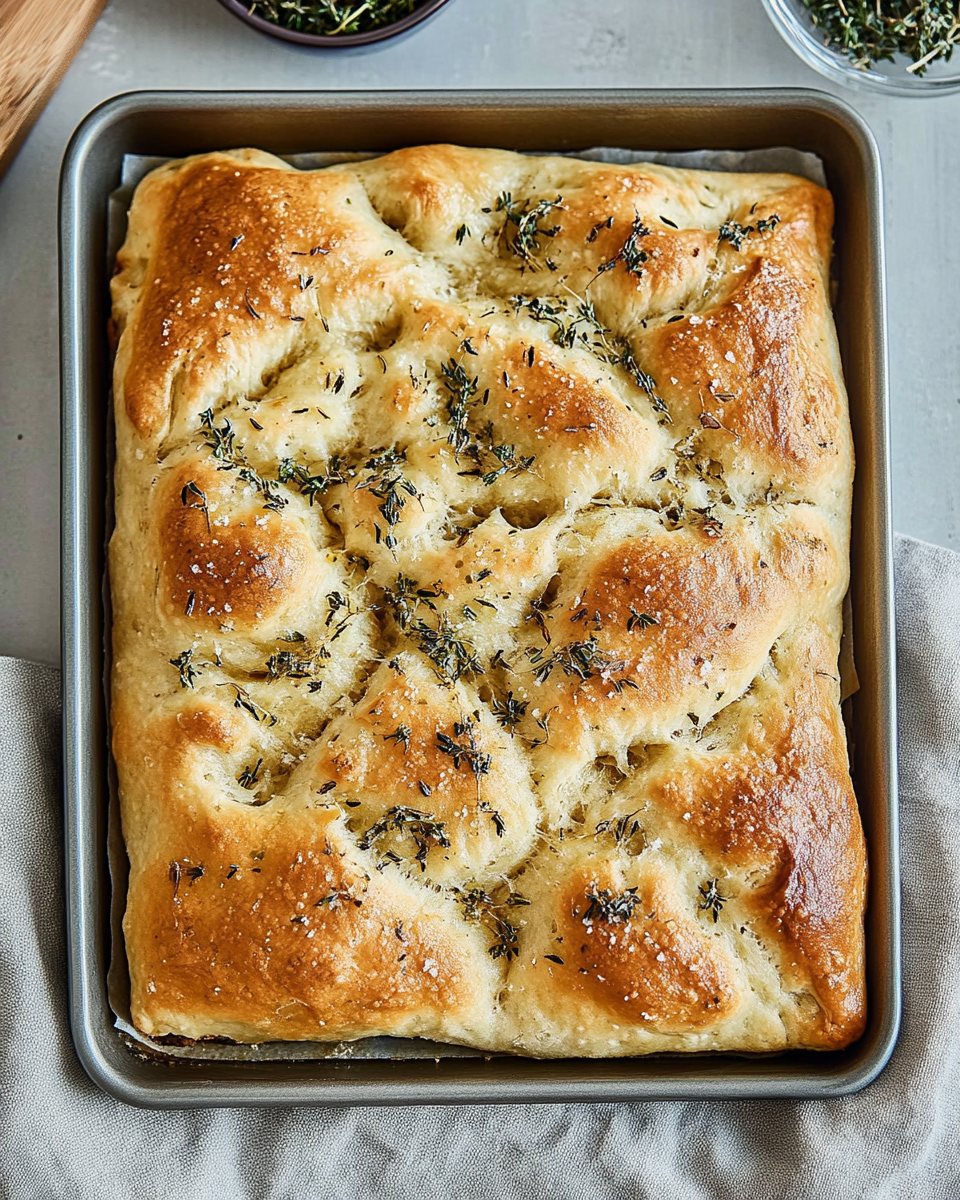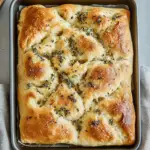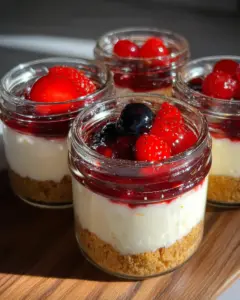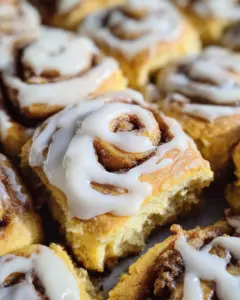Easy Homemade Focaccia Bread is a rustic Italian classic that combines simplicity with rich, satisfying flavors. Known for its crispy golden crust and soft, airy interior, this bread is a versatile addition to any meal. Whether you’re serving it as a side for soups, using it as a base for sandwiches, or enjoying it on its own, this no-knead focaccia is a crowd-pleaser. The recipe requires just a handful of ingredients and minimal effort, making it perfect for both beginners and experienced bakers. The long fermentation process enhances the bread’s flavor, while the dimpled surface adds a unique texture that’s both visually appealing and delicious.

Preparation Phase & Tools to Use
Before diving into the recipe, it’s important to gather the right tools and understand their roles. Here’s what you’ll need:
- Large Mixing Bowl: A spacious bowl ensures the dough has enough room to expand during fermentation. This is crucial for achieving the bread’s signature airy texture.
- Wooden Spoon: Ideal for mixing the dough without overworking it. A wooden spoon helps combine the ingredients gently, preserving the dough’s structure.
- Plastic Wrap: Keeps the dough moist and prevents it from drying out during refrigeration. Proper coverage ensures the dough rises evenly.
- 9×13-inch Baking Pan: The perfect size for achieving the right thickness and texture. A metal or glass pan works best for even heat distribution.
- Non-Stick Spray: Prevents the bread from sticking to the pan, making it easier to remove after baking.
- Wire Rack: Allows the bread to cool evenly and prevents the bottom from becoming soggy. Cooling on a wire rack ensures the crust stays crisp.
- Measuring Tools: Accurate measurements are essential for consistent results. Use a digital scale for precision, especially with flour and water.
Importance of Each Tool
Each tool plays a critical role in ensuring your homemade focaccia turns out perfectly. The large mixing bowl accommodates the dough’s growth, while the wooden spoon helps mix the ingredients gently. Plastic wrap maintains the dough’s moisture, and the baking pan ensures even baking. A wire rack is essential for cooling, and measuring tools guarantee precision.
Preparation Tips
- Use lukewarm water to activate the yeast effectively. The ideal temperature is around 100°F (38°C).
- Always add salt and yeast to opposite sides of the bowl to prevent direct contact, which can hinder yeast activity.
- Refrigerate the dough for at least 18 hours to develop flavor and texture. This slow fermentation process is key to the bread’s unique taste.
- Let the dough rise in a warm, draft-free area for optimal results. A slightly warm oven (turned off) or a sunny spot works well.
Ingredients
For the Dough:
- 500 g (4 cups) bread flour
- 7 g (2 ¼ teaspoons) instant yeast
- 2 teaspoons kosher salt
- 480 g (2 cups) lukewarm water
- 6 tablespoons extra-virgin olive oil, divided
For Topping:
- Flaky salt, for sprinkling
- 1 tablespoon chopped rosemary (optional)
Step-by-Step Directions
- In a large bowl, combine bread flour. Add instant yeast and kosher salt on opposite sides.
- Mix the dry ingredients, then create a well in the center. Pour in lukewarm water and stir until a shaggy dough forms.
- Drizzle 2 tablespoons of olive oil over the dough and rub it in. Cover with plastic wrap and refrigerate for 18-72 hours.
- Prepare a 9×13-inch baking pan by spraying it with non-stick spray and drizzling 2 tablespoons of olive oil.
- Shape the dough into a ball and transfer it to the pan. Let it rise for 3-4 hours.
- Preheat the oven to 425°F (218°C). Drizzle the remaining olive oil over the dough and add rosemary (if using).
- Create dimples with your fingers and sprinkle flaky salt. Bake for 25-30 minutes until golden brown.
- Cool in the pan for 5 minutes, then transfer to a wire rack. Slice and serve after 10 minutes.
Easy Homemade Focaccia Bread is incredibly versatile and can be served in numerous ways. Its crispy crust and soft interior make it a perfect accompaniment to a variety of dishes. Here are some ideas to inspire your next meal:
- As a Standalone Snack: Serve the focaccia warm, drizzled with a bit of extra-virgin olive oil and a sprinkle of flaky salt. Pair it with a small bowl of balsamic vinegar for dipping.
- For Sandwiches: Use slices of focaccia as a base for paninis or sandwiches. Its sturdy texture holds up well to fillings like roasted vegetables, grilled chicken, or mozzarella and tomatoes.
- With Soups and Stews: Focaccia is an excellent side for tomato basil soup, minestrone, or hearty stews. Tear off pieces and dip them into the broth for a comforting meal.
- As Part of a Charcuterie Board: Add focaccia to a charcuterie platter alongside cheeses, cured meats, olives, and fruit. Its savory flavor complements a variety of pairings.
- For Breakfast or Brunch: Serve focaccia with scrambled eggs, avocado slices, or smoked salmon for a delicious morning treat.
Common Mistakes To Avoid & How to Perfect the Recipe
Even though this recipe is straightforward, a few common mistakes can affect the final result. Here’s how to avoid them and ensure your focaccia turns out perfectly:
- Overworking the Dough: Focaccia dough should be handled gently. Avoid kneading or over-mixing, as this can deflate the air pockets and result in a denser texture.
- Skipping the Refrigeration Step: The long fermentation process is crucial for developing the bread’s flavor and texture. Don’t rush this step—allow the dough to rest in the fridge for at least 18 hours.
- Using Cold Water: Always use lukewarm water to activate the yeast properly. Cold water can slow down or prevent yeast activation, while hot water can kill the yeast.
- Overbaking: Keep a close eye on the bread during the final minutes of baking. Overbaking can dry out the focaccia and make the crust too hard. The bread is done when it’s golden brown and pulling away from the sides of the pan.
- Not Adding Enough Olive Oil: Olive oil is a key ingredient that adds flavor and helps create the bread’s signature texture. Don’t skimp on it—use a generous amount for both the dough and the pan.
Side Dish Recommendations
Focaccia pairs beautifully with a variety of side dishes. Here are eight ideas to complete your meal:
- Tomato Basil Soup: The classic pairing for focaccia, this soup’s rich flavors complement the bread’s savory notes.
- Roasted Garlic Hummus: Serve focaccia with a creamy hummus for a satisfying snack or appetizer.
- Caprese Salad: Fresh mozzarella, tomatoes, and basil drizzled with balsamic glaze make a light and refreshing side.
- Grilled Vegetables: Zucchini, bell peppers, and eggplant grilled to perfection add a smoky contrast to the bread.
- Italian Antipasto Platter: A mix of cured meats, cheeses, olives, and marinated vegetables creates a festive spread.
- Creamy Pesto Pasta: The herbaceous flavors of pesto pair wonderfully with focaccia.
- Minestrone Soup: This hearty Italian soup is a filling and flavorful companion to the bread.
- Marinated Olives and Artichokes: A tangy and briny side that enhances the focaccia’s richness.
To elevate your easy homemade focaccia bread, consider these additional tips and variations:
- Experiment with Toppings: While rosemary and flaky salt are classic choices, you can customize your focaccia with other toppings. Try sundried tomatoes, caramelized onions, garlic cloves, or olives for added flavor.
- Add Herbs to the Dough: For an extra layer of flavor, mix thyme, oregano, or basil into the dough before refrigerating.
- Use High-Quality Olive Oil: Since olive oil is a key ingredient, opt for a high-quality extra-virgin olive oil to enhance the bread’s taste.
- Create Patterns: Use your fingers to create decorative patterns in the dimples, or arrange toppings in a specific design for a visually appealing finish.
- Adjust Baking Time: If you prefer a softer crust, reduce the baking time slightly. For a crispier crust, leave the bread in the oven for a few extra minutes.
Storage and Reheating Instructions
Proper storage ensures your focaccia stays fresh and delicious. Here’s how to store and reheat it:
- Room Temperature: Store leftover focaccia in an airtight container or wrapped in aluminum foil at room temperature for up to 2 days. This helps maintain its texture and flavor.
- Refrigeration: For longer storage, place the bread in the fridge for up to 5 days. However, refrigeration can dry out the bread, so bring it to room temperature or reheat before serving.
- Freezing: Focaccia freezes well. Wrap it tightly in plastic wrap and then in aluminum foil to prevent freezer burn. Freeze for up to 3 months. Thaw at room temperature or reheat directly from frozen.
- Reheating: To restore the bread’s freshness, reheat it in a 350°F (175°C) oven for 5-10 minutes. You can also toast individual slices in a toaster or skillet for a quick snack.
FAQs
Here are answers to some common questions about making easy homemade focaccia bread:
- Can I use all-purpose flour instead of bread flour?
Yes, you can substitute all-purpose flour, but the texture may be slightly less chewy. Bread flour has a higher protein content, which contributes to the bread’s structure. - How do I know if the yeast is active?
If the dough doubles in size during the rise, the yeast is active. If it doesn’t rise, the yeast may be expired or the water temperature may have been too hot or cold. - Can I freeze focaccia?
Absolutely! Wrap it tightly in plastic wrap and aluminum foil, then freeze for up to 3 months. Thaw at room temperature or reheat directly from frozen. - What’s the best way to achieve a crispy crust?
Ensure the oven is fully preheated and use a generous amount of olive oil on the dough and in the pan. Baking the bread on the middle rack also helps achieve an even crust. - Can I make this recipe gluten-free?
While this recipe is designed for bread flour, you can experiment with gluten-free flour blends. Keep in mind that the texture may differ from traditional focaccia. - Why is my focaccia dense?
A dense focaccia can result from overworking the dough, insufficient rising time, or inactive yeast. Ensure you follow the recipe’s instructions carefully.
Conclusion
Easy Homemade Focaccia Bread is a rewarding and versatile recipe that brings the flavors of Italy to your kitchen. With its crispy crust, soft interior, and endless customization options, it’s a bread you’ll want to make again and again. Whether you’re a beginner or an experienced baker, this recipe is simple enough to follow yet impressive enough to serve at any gathering.
By following the detailed steps, avoiding common mistakes, and experimenting with toppings and variations, you’ll create a focaccia that’s both delicious and visually appealing. Pair it with your favorite soups, salads, or dips, or enjoy it on its own as a satisfying snack.
With proper storage and reheating techniques, you can enjoy your focaccia for days—or even months—after baking. So, roll up your sleeves, gather your ingredients, and get ready to bake a loaf of easy homemade focaccia bread that will delight your taste buds and impress your family and friends.
Easy Homemade Focaccia Bread
Ingredients
For the Dough:
- 500 g 4 cups, spoon and leveled bread flour
- 7 g 2 1/4 teaspoons or 1 standard packet instant yeast
- 2 teaspoons kosher salt
- 480 g 2 cups lukewarm water (see notes for preparation)
- 6 tablespoons high-quality extra-virgin olive oil divided
For Topping:
- Flaky salt for sprinkling
- 1 tablespoon chopped rosemary optional
Instructions
Mix the Dough:
- In a large bowl, combine the bread flour. Add the yeast and kosher salt on opposite sides of the bowl to prevent direct contact initially.
- Use your fingers to mix the dry ingredients together, then create a well in the center.
- Pour in the lukewarm water and stir with a wooden spoon until a wet, shaggy dough forms.
Oil the Dough:
- Drizzle 30 g (2 tablespoons) of olive oil over the dough’s surface. Use your fingers to rub the oil over the dough.
- Gently wiggle the dough from the edges of the bowl to coat the sides and bottom with oil.
- Cover the bowl tightly with plastic wrap and refrigerate for at least 18 hours, up to 72 hours.
Prepare the Baking Pan:
- Spray a 9×13-inch baking pan with non-stick spray and drizzle 30 g (2 tablespoons) of olive oil in the center. Set aside.
Shape the Dough:
- Remove the dough from the fridge. Use your fingers to pull the edges of the dough towards the center while rotating the bowl, forming it into a ball.
- Transfer the dough to the prepared baking pan, turning it a few times to coat the entire surface in olive oil.
- Leave the dough uncovered to rise in a warm, draft-free place for 3-4 hours, until it nearly fills the pan.
Preheat the Oven:
- Towards the end of the second rise, preheat the oven to 425°F (218°C).
- Create Dimples & Add Toppings:
- Drizzle the remaining 30 g (2 tablespoons) of olive oil over the dough and rub it evenly over the surface.
- If using, sprinkle chopped rosemary evenly over the dough.
- Use your fingers to press straight down into the dough, creating deep dimples all over. Gently stretch the dough to fill the corners of the pan, if needed.
- Sprinkle flaky salt over the top.
Bake the Bread:
- Bake for 25-30 minutes, or until golden brown and pulling away from the sides of the pan.
- Let the focaccia cool in the pan for 5 minutes, then carefully transfer it to a wire rack (use a large metal spatula if needed) to prevent the bottom from getting soggy.
- Allow it to cool for 10 minutes before slicing and serving.
- Notes
- Lukewarm Water: Combine 360 g (1 ½ cups) cold water with 120 g (1/2 cup) boiling water to achieve the perfect temperature.
- Storage: Store leftovers in an airtight container at room temperature. Focaccia is excellent for toasted paninis, breakfast sandwiches, or other sandwiches!






